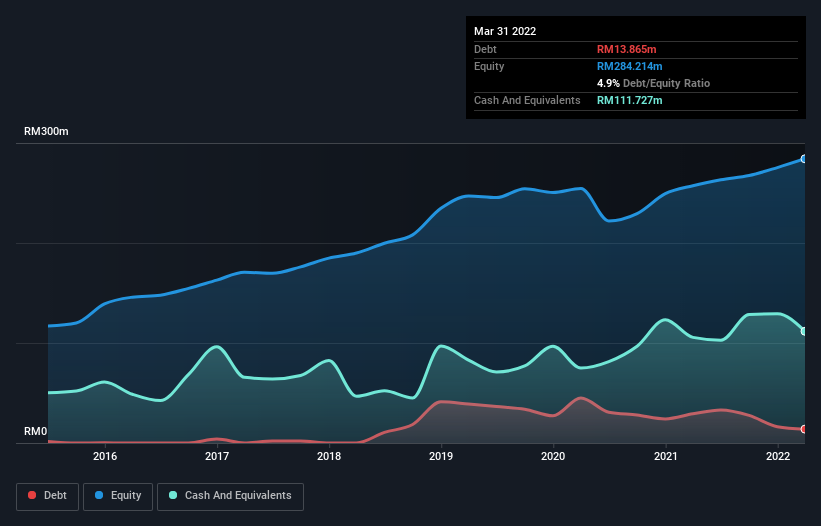Legendary fund manager Li Lu (who Charlie Munger backed) once said, 'The biggest investment risk is not the volatility of prices, but whether you will suffer a permanent loss of capital.' So it seems the smart money knows that debt - which is usually involved in bankruptcies - is a very important factor, when you assess how risky a company is. We can see that AWC Berhad (KLSE:AWC) does use debt in its business. But is this debt a concern to shareholders?
Why Does Debt Bring Risk?
Generally speaking, debt only becomes a real problem when a company can't easily pay it off, either by raising capital or with its own cash flow. Part and parcel of capitalism is the process of 'creative destruction' where failed businesses are mercilessly liquidated by their bankers. However, a more usual (but still expensive) situation is where a company must dilute shareholders at a cheap share price simply to get debt under control. By replacing dilution, though, debt can be an extremely good tool for businesses that need capital to invest in growth at high rates of return. When we think about a company's use of debt, we first look at cash and debt together.
Check out our latest analysis for AWC Berhad
How Much Debt Does AWC Berhad Carry?
The image below, which you can click on for greater detail, shows that AWC Berhad had debt of RM13.9m at the end of March 2022, a reduction from RM29.2m over a year. However, its balance sheet shows it holds RM111.7m in cash, so it actually has RM97.9m net cash.

How Healthy Is AWC Berhad's Balance Sheet?
The latest balance sheet data shows that AWC Berhad had liabilities of RM102.7m due within a year, and liabilities of RM6.63m falling due after that. On the other hand, it had cash of RM111.7m and RM180.3m worth of receivables due within a year. So it can boast RM182.7m more liquid assets than total liabilities.
This excess liquidity is a great indication that AWC Berhad's balance sheet is almost as strong as Fort Knox. With this in mind one could posit that its balance sheet means the company is able to handle some adversity. Succinctly put, AWC Berhad boasts net cash, so it's fair to say it does not have a heavy debt load!
Better yet, AWC Berhad grew its EBIT by 106% last year, which is an impressive improvement. If maintained that growth will make the debt even more manageable in the years ahead. The balance sheet is clearly the area to focus on when you are analysing debt. But you can't view debt in total isolation; since AWC Berhad will need earnings to service that debt. So if you're keen to discover more about its earnings, it might be worth checking out this graph of its long term earnings trend.
Finally, a company can only pay off debt with cold hard cash, not accounting profits. While AWC Berhad has net cash on its balance sheet, it's still worth taking a look at its ability to convert earnings before interest and tax (EBIT) to free cash flow, to help us understand how quickly it is building (or eroding) that cash balance. During the last three years, AWC Berhad generated free cash flow amounting to a very robust 95% of its EBIT, more than we'd expect. That puts it in a very strong position to pay down debt.
Summing up
While we empathize with investors who find debt concerning, the bottom line is that AWC Berhad has net cash of RM97.9m and plenty of liquid assets. And it impressed us with free cash flow of RM33m, being 95% of its EBIT. At the end of the day we're not concerned about AWC Berhad's debt. There's no doubt that we learn most about debt from the balance sheet. But ultimately, every company can contain risks that exist outside of the balance sheet. Be aware that AWC Berhad is showing 3 warning signs in our investment analysis , and 1 of those is concerning...
If you're interested in investing in businesses that can grow profits without the burden of debt, then check out this free list of growing businesses that have net cash on the balance sheet.
New: Manage All Your Stock Portfolios in One Place
We've created the ultimate portfolio companion for stock investors, and it's free.
• Connect an unlimited number of Portfolios and see your total in one currency
• Be alerted to new Warning Signs or Risks via email or mobile
• Track the Fair Value of your stocks
Have feedback on this article? Concerned about the content? Get in touch with us directly. Alternatively, email editorial-team (at) simplywallst.com.
This article by Simply Wall St is general in nature. We provide commentary based on historical data and analyst forecasts only using an unbiased methodology and our articles are not intended to be financial advice. It does not constitute a recommendation to buy or sell any stock, and does not take account of your objectives, or your financial situation. We aim to bring you long-term focused analysis driven by fundamental data. Note that our analysis may not factor in the latest price-sensitive company announcements or qualitative material. Simply Wall St has no position in any stocks mentioned.
About KLSE:AWC
AWC Berhad
An investment holding company, provides integrated facilities management and engineering services.
Excellent balance sheet and fair value.
Similar Companies
Market Insights
Community Narratives




